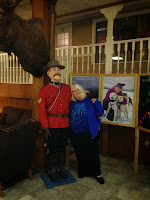All the things that I am proud of are accomplishments of the entire Traumatic Stress Institute team, which consists of me, Steve Brown, Michelle Kenefick and Marci Marciniek. They also reflect the support of the Klingberg agency, particularly of the CEO Steve Girelli and the Executive Team, Dave Tompkins, Joe Milke, Mark Johnson and Eileen King. Many other Klingberg staff have contributed, notably Rebecca Desautels and Christine Keys.
Personally I continue to be proud of my book, Trauma Informed Care: The Restorative Approach (ww.nearipress.org). It was wonderful to attend a conference in Florida a couple of weeks ago and hear from so many people I didn’t previously know how much they liked the book and how it was transforming their treatment programs. It is very exciting to me that I am helping treaters offer more effective healing.
I did a lot of traveling and teaching this fall. It was tiring, but I was privileged to meet many caring and thoughtful people who are working hard to help trauma survivors heal. I am proud of the positive feedback I got, and of comments such as the foster mother who told me that my keynote helped her feel more hope for her relationship with her teenaged foster daughter.
Speaking of foster parents, one of our greatest achievements has been the adaptation of Risking Connection for training caretaking families. This was accomplished with the help of Elizabeth Power. We offered this training at Klingberg in our Therapeutic Foster Care Program, and one foster mother said she was delighted to see the "lightbulbs going off" above her husband's head. She felt their parenting would be more in sync after the training. Our trainers felt the foster parents were so grateful to be able to understand their children's behavior in a new way and have a road map for how to parent.
Another adaptation that I am proud of is Risking Connection with Native Hawaiian Values, done in conjunction with Joey McKeague of Child and Family Service. RC already fit well with the Native values of healing through relationships and Ho‘oponopono: the traditional ways of healing to make things right. So it was delightful to add Hawaiian sayings, concepts, pictures, music and exercises to adapt the training further. Not only is this training receiving great feedback in Hawaii, the curriculum is serving as a model for a First Nation adaptation in Canada.
One of my greatest areas of pride is the support and professional development that the Traumatic Stress Institute offers our Associate Trainers. Through local events and webinars we bring to our trainers the latest developments in trauma theory, treatment techniques, and teaching skills. These events contain great depth of thought and emotion. The credit for this program goes to Steve Brown, who planned and executed it. This year we offered such topics as treating self harm, preventing staff sexual abuse of clients, and using supervision to sustain trauma informed care. We also require Recertification every two years, during which we also bring new ideas and skills to our trainers. Many of our Associate Trainers are supervisors and leaders in their agencies, and so through our professional development we improve the quality of treatment throughout the country.
We added a new type of offering for our trainers this year- a Mindfulness Retreat. This was led by our Michelle Keneflick. It took place at a lovely location beside the ocean, and included meditation, walking a labyrinth, a silent meal, and sharing. The trainers (who as mentioned are leaders and spend a lot of time caring for their staff and clients) spoke eloquently of how much they needed this day for themselves. They learned techniques they could use with others, but more importantly were restored and renewed themselves.
ACEs
Another new offering for our trainers is our list serve group, which is housed at www.acestoohigh.org. This has just begun, again as a result of effort by Michelle and Steve Brown. Our hopes are that it will evolve into a vehicle for creating a greater sense of community between our trainers. Through this mechanism they will be able to earn from each others' discoveries in both training and treatment methods. It also connects them with a larger community of people who are working to decrease the adverse childhood experiences for our children.We have made some progress in research. We are completing a study in the Yukon Territory of Canada which investigates the effect of Risking Connection training on a treatment system. We are also in the midst of refining and improving our Trauma Informed Belief Measure, which measures changes in beliefs favorable to trauma informed treatment. This will be a big contribution to the field, as it is currently difficult to measure changes that take place as agencies transform their practice. Steve Brown's persistence has made this possible, and our wonderful researcher Courtney Baker of Tulane University has directed the work.
Of course we have also continued our training, offering Risking Connections basic and train-the-trainer as well as the Restorative Approach throughout the year. We continue to receive feedback that this is the best training that people have ever had, that it changes their life. I am gratified when I return to a place I trained several years earlier and discover how much has changed due to the new perspective. For example, in Hawaii the group homes we trained had reduced both run aways and restraints to nearly zero, when these had both been major concerns prior to the training. We have also offered trainings about vicarious trauma.
As many of you know, my colleague Steve Brown is an expert in teaching healthy sexuality as well as treating problem sexual behaviors. He has combined this knowledge with his expertise in trauma to facilitate connections between different helping worlds. For example, he spoke at a conference about promoting healthy sexuality in the domestic violence world, and then recently about trauma informed healthy sexuality education. Often these various helping segments do not communicate with each other. Steve is helping bridge this gap. He continues to consult in difficult treatment cases involving problem sexual behaviors, and has helped treatment teams find direction with these youth. He also continues to teach Streetwise to Sexwise, based on his book which is a curriculum for teaching healthy sexuality to high risk kids.
Of course as I have recorded here before I am intensely proud of being part of the Ana Grace Project and having been part of planning the Love Wins conference. Pictures of the conference are available at www.anagraceproject.org. It was everything we hoped it would be- educational, inspiring, community building.
And there is more I'm sure that I am leaving out....
So what next?
I am interested in the topic of sustaining trauma informed care. More and more treaters are going to training and making some changes... but it is amazing how quickly those changes can evaporate in the faces of the challenges of our work. So expect more writing, training, help in the area of how to sustain this approach.
A focus on combating vicarious traumatization is an essential part of sustaining trauma informed care. We hope to offer more retreats and regeneration experiences, using art, music, mindfulness, yoga, etc. We'd like to be able to offer these to teams at agencies. Would that interest you? Cultivating vicarious transformation is another interest of mine.
I want to develop a train-the-trainer structure for the Restorative Approach, and train some trainers besides myself. Another part of sustainability.
We would like to expand our use of social media, offer more in the cyber world. Developing our trainer community is one part of that. Webinars for the treatment public are another possibility.
We hope to finish our research, and publish and disseminate our Belief's Measure.
It would be interesting to expand the trauma/healthy sexuality connection, there seem to be many possibilities. Steve will be working on a revision and updating of his book.
We are working on some new, soon-to-be-revealed projects in the areas of evaluation and prevention. As I mentioned we are also hoping to do an RC adaptation for First Nation people in Canada.
How about you- what do you need? What could we do that would be most helpful to you?
I am confident that in 2014 we will continue to assist the treaters in our field offer more effective and compassionate healing to the people who need it most, and to take the best possible care of themselves and each other. And I will chronicle the journey in the next hundred blog posts.
Please let us know what you need by clicking on "comment" below.


































